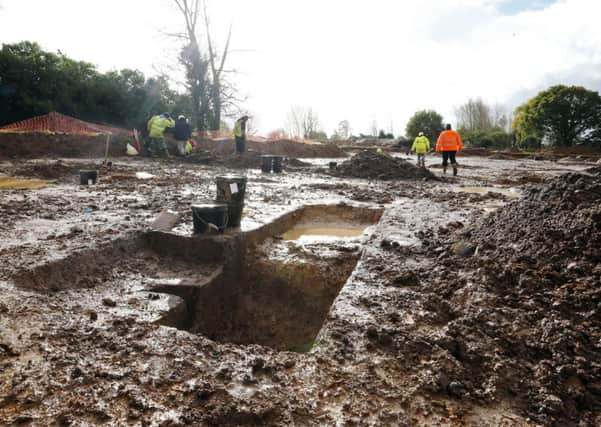Dig uncovers Barnham’s former Roman residents


Archaeologists from West Sussex County Council, Archaeology South-East, and CgMs Consulting have uncovered the remains of what is believed to be an ancient Roman settlement during the archaeological excavation of the former Angel’s and Hyde Nurseries, off Yapton Road.
The remains of the timber buildings, which would probably have existed here, have not survived 2,000 years of ploughing and, most recently, nursery gardening. But rubbish pits full of Roman pottery, and ditches, which would once have had earth banks alongside them, can still be seen below topsoil.
Advertisement
Hide AdAdvertisement
Hide AdCounty council senior archaeologist John Mills said: “This is the first good evidence we have for a Roman settlement in Barnham. Banks and ditches surrounded a square plot of land – an enclosure – and two smaller rectangular enclosures behind it, in which the local Romanised Britons were probably living, and certainly burying their household rubbish, in. Nothing was known about there having been a Roman settlement on this site before the recent archaeological investigation.”
The excavation work has been undertaken as a condition of planning permission granted to the county council for development of the land by Arun District Council.
The settlement, which continued until after 200 AD, may have started life even before the Roman Conquest of 43 AD in the Late Iron Age.
It was essentially agricultural. Parts of quern stones – round flat gritty stones, upper and lower, turned by hand to grind corn between them - have been found in the recent excavations.
Advertisement
Hide AdAdvertisement
Hide AdOn the final day of the dig last week, evidence of an old pond and water management facilities, like drains and ditches, was discovered.
John added: “As often happens on Time Team, there was a surprise on this last day of the investigation.”
Other revelations uncovered at the site included a number of fragments of household pottery obtained by the ancient villagers from kilns in the Arun Valley, Rowlands Castle and the New Forest.
John added: “This was fine, expensive tableware imported from kilns in central France, usually found in England in well-to-do households.”
Advertisement
Hide AdAdvertisement
Hide AdSo far, the site has proved to be a real draw for villagers, with more than 200 joining an open afternoon to catch a glimpse of the excavation area.
Lionel Barnard, county council cabinet member for residents services, said: “We know that this area is rich in history and home already to some really significant historical finds but that doesn’t make discoveries like this any less exciting.”